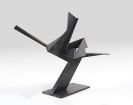
Constructivism
Constructivism is an artistic style that appeared in Russia around 1913. It concentrated on strictly geometric composition, and for this reason was non-representational. In this approach, constructivist (lat. "constructio" = structure) artists strove at the same time for a certain tectonics. The constructive nature of their art lay in building a composition by means of simple geometric building blocks. Constructivism received important impulses from cubism and from the dynamic fragmentation of futurism, which also put together their compositions from geometricizing shapes. Within the constructivist group itself, there were two strands: while one part concentrated itself on a functional constructivism and thought about architecture, design and typography, the suprematic group around Malewitsch strove for a pure form of art that retreated from every social obligation. Constructivism established itself in any case after the October Revolution in both forms as the official Russian state art; in the political turmoil, however, many constructivists emigrated to the West, where they joined groups such as de Stijl or Bauhaus. For this reason, the designation "constructivist" is often used for other styles of modern art that follow similar principles.
Related artists: Archipenko, Alexander | Baumeister, Willi | Calder, Alexander | Chillida, Eduardo | Delaunay-Terk, Sonia | Dexel, Walter | Fleischmann, Adolf Richard | Fruhtrunk, Günter | Hauser, Erich | Hirst, Damien | Hölzel, Adolf | Itten, Johannes | Kandinsky, Wassily | Kassák, Lajos | Kerkovius, Ida | Klapheck, Konrad Peter Cornelius | Kliun, Ivan Vassilyevich | Knoebel, Imi | Lissitzky, El | Moholy-Nagy, László | Poliakoff, Serge | Rodchenko, Alexander Mikhailovich | Schwitters, Kurt | Soulages, Pierre | Stella, Frank | Uhlmann, Hans

Would you like to sell a work of Constructivism?
Infos for sellerART MARKET:

Stahlskulptur
Sculpture. Black-tinted steel, 1961
Post-Auction Sale 40.000
More offers >



